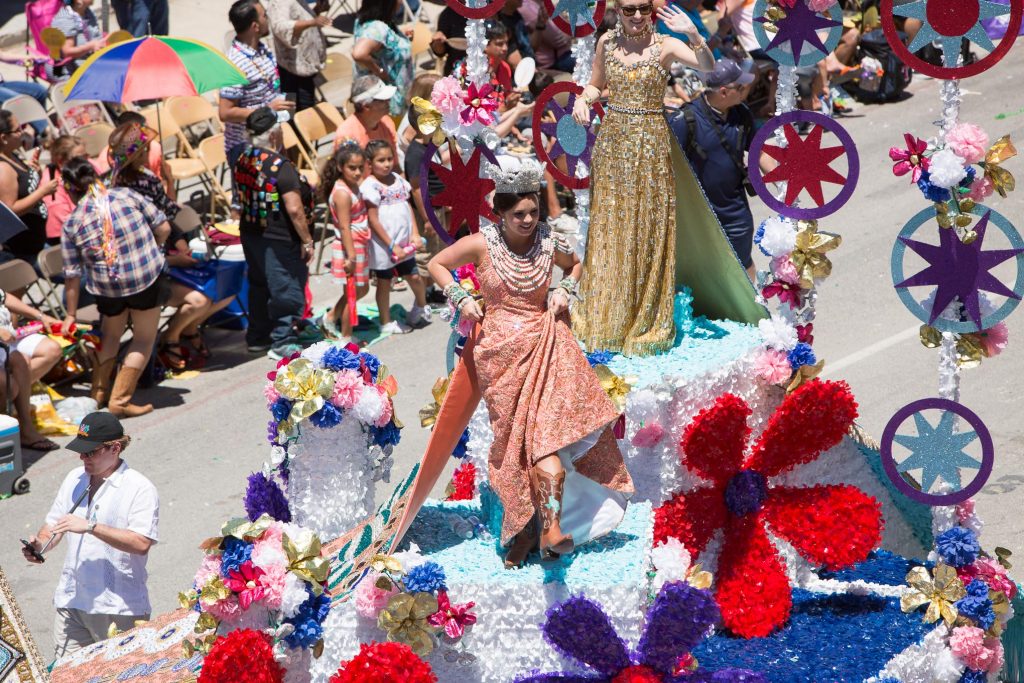Colorful floats; streets closed with barricades; people covering the sidewalks and setting up their lawn chairs to have a good view, having the day off from school; the Marching Bands from High Schools and Universities, decorating their instruments with ribbons, preparing their formation under Highway 37 on Grayson Street; the Fiesta Royalty putting on their best pairs of decorated shoes before stepping onto their throne, mounted on one of the biggest of the parade floats. If you’re a native San Antonian, you know exactly what grand celebration is about occur and what has been going on for the days before; it is part of Fiesta, the ten-day city-wide celebration; it is the Battle of Flowers parade. The Battle of Flowers is a 2.6-mile parade that runs through downtown San Antonio, typically one of the closing events of the Fiesta celebration. This Parades begins on the edge of downtown, and continues onto three major streets: Broadway, Alamo, and Commerce.1 Local schools participate in this parade; their dance troops, mariachi bands, ROTC, and Marching Band programs participate and walk the parade alongside the Texas Cavaliers, the Fiesta Royalty, and the Mayor. Although this annual event has become a hallmark for San Antonians, many don’t know how or when it all began. Let’s go back to its origins, back to the last decade of the nineteenth century in San Antonio.

Originating in 1891, the Battle of Flowers parade was created as a tribute to all those who fought and who fell at the Battles of San Jacinto and the Alamo.2 The idea of a grand celebration to commemorate these heroes came from a tourist, the native-Chicagoan W. J. Ballard. He believed that a proper tribute should be made, and asked a group of local ladies why this had not been the case just yet. His question extended through the city and made its way into newspapers and gained the approval of the community almost instantly. The anticipated idea aroused a spark of interest in Ellen Maury Slayden, a native Virginian elite, who had found her way to San Antonio by marriage to a merchant and later congressman, James L Slayden. Slayden then decided to bring Ballard’s idea to life, and since she knew it was almost impossible on her own, she decided to enlist the help of another newcomer to the area, J. S. Alexander. They both decided to take this on as a pet project of theirs, with the help and support of their husbands. Alexander, a banker before arriving in Texas, provided information on some familiarity he had had overseas about seeing a parade surrounded by flowers, where carts were decorated with flowers. Slayden also remembered similar instances in celebrations she knew about across Mexico and Spain, giving the basis for what the parade would become. The husbands, and many of the elite men of San Antonio, took over the project and had gentlemen speak on behalf of the ladies at the committee meetings; however, as the project grew, the ladies wanted to make sure that it was still a women’s project and continued to provide input and ideas, thus creating the Battle of Flowers Association.3

The parade was originally intended to be an April 21st celebration to celebrate the 55th anniversary of the victory of the Battle of San Jacinto; however, coincidentally, San Antonio was just then expecting its first-ever visit from the White House, the 23rd president of the United States, President Benjamin Harrison. As soon as word got out, the city became ecstatic and prepared a celebration to welcome the President, including moving the parade a day ahead of its original date. With the dates set in stone, the first official planning committee meeting took place only a mere seven days prior to the event. They were frantically trying to gather flowers from nearby towns, since San Antonio had just experienced some heavy rains, which had destroyed most flower gardens, leaving the city with a shortage of flowers just before the parade. Trains were rushed in with shipments of flowers from nearby towns. Other means of making up for the shortage were discussed as well, such as dressing the children up as flowers and having bicyclists decorate their mobiles with whatever blossoms they found and join the parade.4 In the days leading up to the parade, everything seemed all set to go, except for the weather. The city had been plagued with days of heavy rain, and the whole city was hopeful that the rains would cease as the day approached; however, they were wrong. On the morning of the parade, the rains didn’t have mercy on their plans, and as the President’s train arrived, the downpour became continuous. But the rains didn’t stop the city from providing the President with a warm welcome; however, it did postpone the flower parade for the following week, which, of course, would mean that the President would be long gone by then. When the warm weather finally arrived the following week, the parade went as planned; and it was so successful that the committee pushed to have it continue as an annual celebration. It has since been celebrated since 1891, except for the years during World Wars I and II.5

By 1985, the parade continued to grow into the week-long celebration known today as Fiesta. And as the years went by, Kings and Queens were elected as Fiesta Royalty.6 The Parade continues to grow, and so does its recognition across the city and the state. It is now funded by private associations. To this day the parade is one of the closing events of the city-wide, week-long Fiesta party and continues to generate community involvement. Every April, San Antonio puts on a fantastic show, and without a doubt, it all goes back to a Chicagoan tourist, two ladies, and one united community.

- Battle of Flowers, Official Website: Battle of Flowers About us (battleoflfowers.org, 2018). ↵
- Handbook of Texas, June 2010, s.v “Fiesta San Antonio,” by Mrs. Willard E. Simpson, Jr. ↵
- Jack Maguire, A Century of Fiesta in San Antonio (Austin, Texas: Eakin Press, 1990), 13-15. ↵
- Jack Maguire, A Century of Fiesta in San Antonio (Austin, Texas: Eakin Press, 1990), 17. ↵
- Jack Maguire, A Century of Fiesta in San Antonio (Austin, Texas: Eakin Press, 1990), 17; Laura Hernandez-Ehrisman, Inventing the Fiesta City, Heritage and Carnival in San Antonio (New Mexico Press,2008), 21. ↵
- Handbook of Texas, June 2010, s.v. “Fiesta San Antonio,” by Willard E. Simpson, Jr. ↵



117 comments
Hanadi Sonouper
San Antonio’s history is very lively and open, when I think about the city’s historical significance the Alamo usually comes to mind and that is basically it. However, after reading this article it has made me more aware that San Antonio has so much culture the preoccupies the entire city with a colorful festival. It is amazing to read and watch the entire city come together to show their proud colors to celebrate its historical background and independence. The images really brings the article to life, full of life and color, the article was great to read! Great work
Natalia Flores
I’ve never attended Fiesta before since I don’t like crowds, but its interesting to hear about it. I’ve only heard about the flowers so this article gave me insight into what the actual event is. The pictures are very colorful and I can only imagine the old school parades with the automobiles covered in flowers. What I do not understand is how it came to be called Fiesta since they just finished fighting Mexico…and to keep slavery in Texas for that matter…
Maria Esquivel
I love San Antonio and I enjoy reading about its culture and history. Therefore, I was very excited to read about the Battle of Flowers and how it originated. I found this article very interesting in the way it portrayed the city of San Antonio and this parade beautifully. It makes me excited to attend one of these parades one day. This article was very well-written and provided great details on the history of the Battle of Flowers. Incredible job on the images selected, it made the article even more vibrant.
Arianna Kennet
I do not know a lot about Mexican culture as I am not from here but this article played a part in telling me more and opening my mind to new things about their culture. Battle of the Flowers seems like an interesting event that carries much significance. It gives a very colourful feel to the Mexican culture and I am glad I found out about this as I might try to attend it myself to see what it is all about.
Elias Garza
I have always found the Mexican culture so beautiful, especially with all the colors it possesses. I have been in San Antonio for two semesters and I have not heard of the Battle of Flowers but I am interested in going. I feel like it will be a great family event to attend. All in all, this was an outstanding article.
Belia Camarena
I love attending the Battle of Flowers parade, so this article was very interesting to read. I think it is ironic that the tradition was started by people not native to San Antonio, but it was also nice because these people treated San Antonio as their home. I also liked how the parade captures Mexican culture with the incorporation of the flowers, and that it was established to commemorate the fallen soldiers at the Battle of San Jacinto.
Thomas Fraire
This to be such a fun article, it was really interesting and captured Mexican culture very well! Since I have experienced childhood in San Antonio, my most punctual recollections comprise of observing every one of the buoys, groups, and schools walking by! Perusing about the history and sources of this stunning city’s greatest and most delightful occasion is constantly ensured to be an enthralling story. From these sources, the shading and energy of this city and its kin will stay sparkling for ages to come as it is passed down to each other.
Luis Morales
This article was great. I love how it provided an overview of how the parade and Fiesta started in San Antonio. I find it interesting how the Battle of the Flowers is really a story about the Battle for the Alamo. Fiesta is always a great time of the year raises thousands of dollars for local nonprofits and universities. The author did a great job giving the history behind the Battle of Flowers parade. Great job!
Didier Cadena
I had never heard of the battle of the flowers before, so it was really interesting to be able to learn a little bit about it. I was not aware of the history of the whole creation of the festival, and some of it really surprised me. The article does a great job of putting all of the information together and still make it interesting enough to read.
Edgar Ramon
That’s a good name to go with the event and what had to happen to get all the flowers possible. I wonder what that would have been like, living through a parade back in 1891. I do believe that Fiesta however, should just change the name back to the Battle of the Flowers week or something, at least I think it would be better marketing because it sounds more authentic. Fiesta just sounds like Party week, Battle of the Flowers week sounds like something you would plan to go to on a bucket list or a regular family trip.